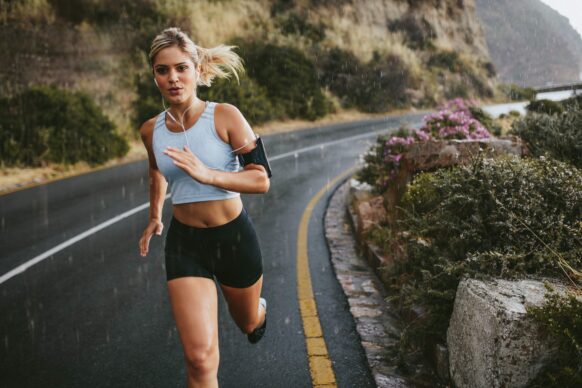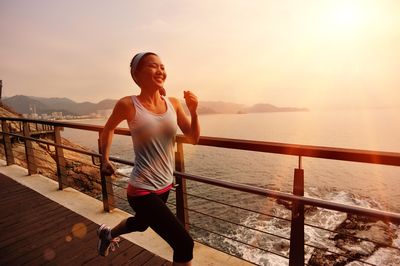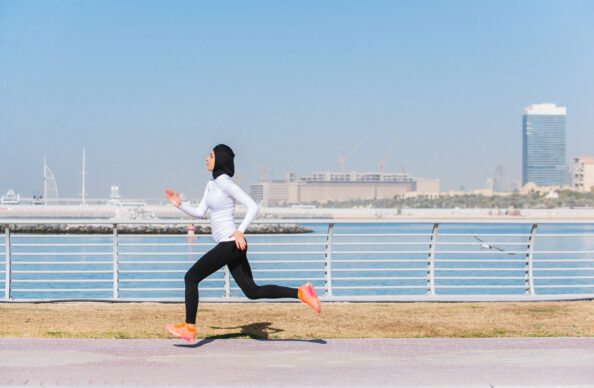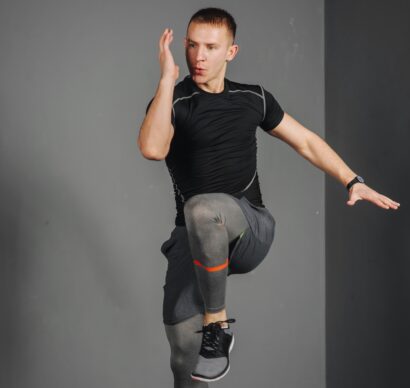By Kristina Bacco, PT, DPT
When it comes to running form and mechanics, hip extension is a very important piece of the overall picture. Greater hip extension range of motion and force will result in a larger stride length and fewer steps per minute. Two primary things are necessary to allow for greater hip extension: glute strength and hip mobility.
Engagement of the glutes allows for the achievement of optimal hip extension and forward propulsion in the late stance phase of the gait cycle. As the hip and knee extend back, the ankle plantar flexes (toes/forefoot press down) to produce forward propulsion. Greater strength in the gluteal muscles, particularly the gluteus maximus, will promote greater forward propulsion force and power.
In order to get optimal propulsion, lateral stability is also an important piece of running biomechanics. Although the more obvious movements of running are within a single plane, running results in multiplanar demands on the body. Lateral stability is necessary for optimal lower extremity alignment and to maintain balance during your movements. This is where the gluteus medius and minimus come into play. The primary motion of these muscles is abduction. When in the stance phase of running (weight bearing phase), these muscles help to stabilize the pelvis so that you do not get excessive dropping or sinking of the pelvis on the contralateral (opposite) side. Since many muscles anchor to the pelvis, it is important to have pelvic stability for optimal muscle function and contraction. Proximal stability facilitates distal mobility.
Even something as simple as gluteal activation exercises immediately prior to your run can improve your stride and propulsion resulting in a faster pace. Try incorporating the following exercises into your running warm-up and be sure to read part 2 of this article which addresses hip joint mobility.
1) Bridges (20-30 reps)
Lay on your back with legs bent up and feet flat on the floor. Arms down at your sides, palms down. Engage your lower abdominals, tighten your glutes and lift your hips up into the air to achieve a straight line from shoulders to knees. Focus on making that lift come from the glutes rather than from the lower back. Be sure to keep knees hip distance apart and do not let them cave inward. Pause at the top, then slowly lower back down with control. Perform 20-30 reps with control.
2) Clamshells (20-25 reps/ each side)
Lay on one side with knees bent to about 90 degrees and legs stacked. Keep your feet together and lift your top knee up to the ceiling. Only lift the knee as high as you can without letting your pelvis rotate or open up backwards. Perform 20-25 reps on each side.
3) Standing Hip Abduction (20-25 reps/ each leg)
Stand near a chair, countertop or wall for light support. Hold on lightly for balance so that you can focus on muscle activation. Kick one leg out to the side, keeping the knee straight. Pause and then slowly bring the leg back down. Do not allow the leg to rotate outwards – keep toes pointed forwards. Only lift as high as you can without leaning or hiking your hip up. Repeat 20-25 reps on each leg.
Next, check out part 2 of this blog addressing the hip mobility portion of this topic. For other great runners’ exercises, check out our post on often-overlooked muscle groups for runners. And as always, feel free to reach out with questions or to request an appointment for a consultation.
Please reach out to expand your strengthening program or to book an appointment with a physical therapist.




